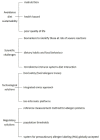Personalized Nutrition Approach in Food Allergy: Is It Prime Time Yet?
- PMID: 30744105
- PMCID: PMC6412250
- DOI: 10.3390/nu11020359
Personalized Nutrition Approach in Food Allergy: Is It Prime Time Yet?
Abstract
The prevalence of food allergy appears to be steadily increasing in infants and young children. One of the major challenges of modern clinical nutrition is the implementation of individualized nutritional recommendations. The management of food allergy (FA) has seen major changes in recent years. While strict allergen avoidance is still the key treatment principle, it is increasingly clear that the avoidance diet should be tailored according to the patient FA phenotype. Furthermore, new insights into the gut microbiome and immune system explain the rising interest in tolerance induction and immunomodulation by microbiota-targeted dietary intervention. This review article focuses on the nutritional management of IgE mediated food allergy, mainly focusing on different aspects of the avoidance diet. A personalized approach to managing the food allergic individual is becoming more feasible as we are learning more about diagnostic modalities and allergic phenotypes. However, some unmet needs should be addressed to fully attain this goal.
Keywords: avoidance diet; food allergy; microbiome; nutrition; personalized nutrition; phenotype.
Conflict of interest statement
The authors declare no conflict of interests.
References
-
- Nwaru B.I., Hickstein L., Panesar S.S., Muraro A., Werfel T., Cardona V., Dubois A.E., Halken S., Hoffmann-Sommergruber K., Poulsen L.K., et al. EAACI Food Allergy and Anaphylaxis Guidelines Group. The epidemiology of food allergy in Europe: A systematic review and meta-analysis. Allergy. 2014;69:62–75. doi: 10.1111/all.12305. - DOI - PubMed
-
- Osborne N.J., Koplin J.J., Martin P.E., Gurrin L.C., Lowe A.J., Matheson M.C., Ponsonby A.L., Wake M., Tang M.L., Dharmage S.C., et al. HealthNuts Investigators. Prevalence of challenge-proven IgE-mediated food allergy using population-based sampling and predetermined challenge criteria in infants. J. Allergy ClinImmunol. 2011;127:e1–e2. doi: 10.1016/j.jaci.2011.01.039. - DOI - PubMed
-
- Boyce J.A., Assa’ad A., Burks A.W., Jones S.M., Sampson H.A., Wood R.A., Plaut M., Cooper S.F., Fenton M.J., Arshad S.H., et al. NIAID-sponsored expert panel. Guidelines for the diagnosis and management of food allergy in the United States: Report of the NIAID-sponsored expert panel. J. Allergy ClinImmunol. 2010;126:S1–S58. doi: 10.1016/j.jaci.2010.10.008. - DOI - PMC - PubMed


